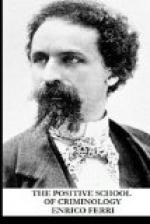For instance, about 3,000 cases of manslaughter are registered every year in Italy. Now, open any work inspired by the classic school of criminology, and ask the author why 3,000 men are the victims of manslaughter every year in Italy, and how it is that there are not sometimes only as many as, say, 300 cases, the number committed in England, which has nearly the same number of inhabitants as Italy; and how it is that there are not sometimes 300,000 such cases in Italy instead of 3,000?
It is useless to open any work of classical criminology for this purpose, for you will not find an answer to these questions in than. No one, from Beccaria to Carrara, has ever thought of this problem, and they could not have asked it, considering their point of departure and their method. In fact, the classic criminologists accept the phenomenon of criminality as an accomplished fact. They analyze it from the point of view of the technical jurist, without asking how this criminal fact may have been produced, and why it repeats itself in greater or smaller numbers from year to year, in every country. The theory of a free will, which is their foundation, excludes the possibility of this scientific question, for according to it the crime is the product of the fiat of the human will. And if that is admitted as a fact, there is nothing left to account for. The manslaughter was committed, because the criminal wanted to commit it; and that is all there is to it. Once the theory of a free will is accepted as a fact, the deed depends on the fiat, the voluntary determination, of the criminal, and all is said.




